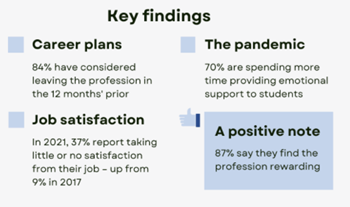Article
Teacher Attrition and Burnout – Inextricably Linked – And Poor Student Behaviour Is Cited as the Catalyst

Being a teacher is not an easy job.
I cannot count how many times people have said to me that they would not want to be a teacher “for all the money in the world”. They cite excessive workload, low pay, a poor work/life balance, unrealistic parent/carer expectations and, above all, having to deal with difficult or badly behaved students.
However, if you ask any current teacher, most will tell you that being a teacher is a very rewarding job and the people who are called into this profession work incredibly hard to educate and care for their students. Having been a teacher and an education leader for many years and having a wife who teaches in a government primary school, I can assure you that most teachers do not do what they do for the money or the ‘supposed’ holidays. As altruistic as it may sound, teachers do what they do because they want to make a difference in the lives of the children that they teach – they help to shape the lives of young people.
Some may also say that the intrinsic rewards of being a teacher are another huge factor. These rewards are usually shaped around those ‘light globe’ moments, when you see that a child has genuinely grasped a concept or has achieved something that they have tried hard to achieve. These are very special moments for teachers who genuinely care.
However, recently released Australian Institute for Teaching and School Leadership (AITSL) Australian Teacher Workforce Data noted that more than half of New South Wales full-time teachers were working more than 60 hours per week, including an average of 35.4 hours on non-face-to-face teaching tasks such as marking and lesson preparation. It is very probable that there is a similar representation of working hours in every other state and territory. The really concerning issue, however, is that this is based on 2018 data. It is also very probable that these hours have also increased due to the complex education issues caused by lockdowns, remote learning and other COVID-19 related issues.
The Daily Telegraph has raised the Australian Teacher Workforce Data in a recent article: NSW schools: Stress and burnout pushes thousands of teachers to think about quitting.
Stress and Burnout and Student Behaviour
According to the Daily Telegraph article “Thousands of teachers are preparing to walk away from the job because of the crazy workload and poor pay — and that was even before the challenges of COVID”. The article estimates that one third of NSW teachers are planning to quit pre-retirement, while another third is simply unsure if they want to stay in the profession.
In addition, the article indicated that many of our teachers, especially those in NSW, where they have had extensive periods of lockdown, are reporting serious behaviour issues from students who are returning to the mainstream classroom environment. The teachers are struggling, with many advising that it may be time to leave the profession.
According to the article, Ruby Blake began full-time teaching in 2022, but said the pressure was already taking a toll. She was quoted as saying “There are discussions about burnout, and I’ve had conversations with other teachers about emotional breakdowns, where the stress is affecting the rest of their lives”.
In 2018, long before the COVID pandemic, and students returning to mainstream classrooms after long periods at home, this matter of very poor student behaviour and a lack of teacher support was raised in TeachWire:
“72% of the teachers we polled claimed to know of former colleagues who had abandoned the classroom because of poor pupil behaviour. Worryingly, the perception of unruliness and indiscipline may be preventing people who might otherwise be good teachers from applying in the first place. 71% of teachers agreed that people are put off from becoming teachers because of poor pupil behaviour. Our research shows that implementing behaviour policies effectively and consistently is the best way to tackle persistent disruptive behaviour. Unfortunately, not all teachers are confident that they will have support from either parents or senior managers within their own schools when it comes to tackling disruptive behaviour.”

In addition, the 2021 NEiTA/ACE Teachers Report Card, produced by the Australian College of Educators, revealed that 88 per cent of teachers had considered quitting the profession since the start of the pandemic.
Their survey of 571 educators from all sectors and jurisdictions found that 60 per cent felt disregarded by parents, more than 75 per cent felt stressed during a typical working week, 37 per cent reported little or no satisfaction from their job and 84 per cent had considered leaving the profession in the last 12 months.
© 2021 NEiTA/ACE Teachers Report Card, Australian College of Educators
Teacher Employment and Attrition- Is COVID to Blame?
Back in 2016, School Governance wrote:
“With the number of new students projected to rise by 26% by 2022, the high number of teachers leaving the profession in their first five years has triggered fears that there will be a shortage of teachers in Australia.”
Even before the COVID-19 pandemic and the immense workload and social disruptions that this has brought to our schools and communities, teachers were reporting that the lack of support combined with the heavy workload was leading to increased strain and exhaustion.
Then, during the height of the pandemic in 2021, School Governance reported that teachers from early childhood to higher education had experienced a significant increase in their workload. One teacher said that the sudden change to online learning created “endless paperwork and programming issues” and “has been relentless”. Another said “It is draining. Exhausting. Time consuming. The work never stops”. Yet another said “I don’t want to teach anymore”. The impact on the mental and physical health of teachers was the next most frequently expressed issue – after the technical, pragmatic and workload issues.
A very quick ‘Google Search’ finds dozens of recent articles that provide further evidence that Australia, along with many other countries, is experiencing a very real teacher shortage and that this will be further compounded by teachers leaving due to dissatisfaction. So, has the COVID pandemic and the issues that we are now seeing in our schools exacerbated the risk of losing good staff? Most certainly yes.
So What Can Schools Do to Attract and Retain Staff?
We wrote the following advice to schools in a 2021 School Governance article. Our advice has not changed:
“In light of predicted increases in teacher resignations, schools should focus on mitigating the biggest risks for teachers leaving the sector. To do so schools will need to review their human resources practices and working culture to identify any potential risks for employee turnover.
It should be borne in mind that teachers are humans and will have varying needs and aspirations so, while an excellent superannuation plan may be very attractive to older staff, having flexibility in work arrangements may be more appealing to teachers with carer responsibilities - whether for their children or for ageing parents. Remuneration above market rates and bonuses may be important to some people in order for them to pay their mortgage while for others it is an indication that their efforts are appreciated.
As a starting point schools should develop a comprehensive Human Resources program that addresses a range of teachers’ needs including, if and where possible, flexible working arrangements, employee entitlements, remuneration and benefits, and the creation of a comprehensive professional development program. It should also address areas that aim to support and remove impediments to good performance, such as solid policies relating to employee welfare, stress management, employee assistance programs, and policies and programs to prevent harassment and bullying.
A regular performance development and review program and mentoring will encourage, support and reward excellence and be an early indicator of any systemic issues that need to be addressed, or unhappy staff.
Obtaining information directly from staff by conducting anonymous surveys or interviewing key staff (not necessarily related to their seniority) can also assist with planning more targeted strategies.
All of this may assist in mitigating the risk of teachers seeking alternative employment and bring significant benefits to a school by saving time and money spent on recruitment, minimising disruption from staff changes, and facilitating a reputation for excellence.
Schools that provide a safe, secure, and innovative workplace are more likely to reinvigorate tired or burnt-out teachers and attract talented teachers that are ready to renew their love of the profession.”
Conclusion – Is it a Bright Future?
In 2021, School Governance wrote an article about World Teachers’ Day where the theme was ‘Bright Future’. We argued that there were two ways to interpret this theme. Some may say that teaching is a career with a bright future. And it is – especially for those who want to make a genuine difference in the lives of the children that they teach. However, the outcomes of the work by our teachers give all of their students a bright future too.
If we are unable to stem the flow of teachers who are wanting to leave the profession due to feeling that they are overworked, unsupported and, above all, undervalued in what they do for our children and society in general, then do we really have a bright future?
About the Author

Craig D’cruz
Resources you may like
Article
Cyber security and AI in schools: emerging risks and governance imperatives
In an era where artificial intelligence (AI) tools are becoming as commonplace as calculators once...
Read MoreArticle
Under 16 social media 'ban’: an explainer for schools
The Australian Government passed a new law called the Online Safety Amendment (Social Media Minimum...
Read MoreArticle
Risk management essentials for schools
Schools face an increasingly complex landscape of risks every day; from safety hazards on school...
Read More
